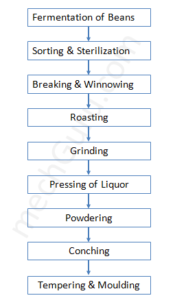There is hardly anyone who hates chocolate. This has made chocolate manufacturing a billion dollar industry with U.S.A being the largest consumer of chocolates. The process of dark chocolate manufacturing goes dates back to 1100 BC and the process remains unchanged, sparing the use of sophisticated machinery in the process.

The process and machinery requires for chocolate manufacturing can be segregated into the following steps:
Fermentation of the bean
The chocolate is manufactured form cocoa beans, which is present in the pod of the cocoa plant. The mature pods are handpicked without damaging the stem and immature pods. The pod contains a cocoa bean in a layer of moist, fibrous white pulp. The pulp and the beans are scooped out and heaped in pile. It is covered by a lid or by banana leaves. The yeast in the pulp, produces alcohols which help fermenting the beans. The mass is stirred to involve oxygen, which converts the alcohols into lactic or acetic acid. The heat generated by this prevents germination if the beans. Finally holes are made such that the liquid produced are drained out and the beans are left behind. A better fermentation process provides better flavor to the cocoa beans.
Sorting and sterilization of beans
The beans after fermentation have a high moisture content. This moisture has to be reduced to 6-7 percent. The process used for drying depends on the climatic conditions. It is mostly done under sunlight in dry places and under sheds with air circulations in places with tropical rain. Once dried, the beans are to be sorted, stored and sold to the chocolate manufacturing industries.
The sorting in modern times is done by sophisticated machinery called the sieve-shaker. It consists of a vibrating screen which sorts the beans into up to five categories. This also removes other impurities. The beans then need to be stored. To prevent contamination of the beans by bacteria, a process known as sterilization is done. This process is done by using vapor controlled treatment. A vapor pressure of 1.5 to 2 bar is applied on the beans, which is followed be a pressure relief. This prepares the beans for the breaker and provide continuous relief during the crushing and separating process. A downstream airflow is provided for drying the beans. It also removes all the residual moisture.
This process of sterilization also aides the removal of the kernel from the bean. This makes the breaking process easy and energy efficient.
Breaking and winnowing of beans
The beans are passed through three stage breakers. It basically consists of three rollers where each consecutive roller rotates faster than the previous one. The beans after being passed through them are cracked. They are not completely crushed but are cracked and they are called cocoa nibs. The kernel is separated from the bean in this process. This is lighter and it can be winnowed by use of a air current from blower fans. These cocoa nibs contain about 53% cocoa butter.
Roasting of beans
The beans are then roasted at a temperature of 140 to 170 degree Celsius. This provides flavor to the beans. Pre-drying is done before this process. It is also called alkylation. The cocoa beans are acidic by nature. In this process, alkalis are added and the pH is brought to 8. This tends enhanced flavor to the chocolate. A continuous roasting process is carried out now. The roasters can be adjusted for different types of cocoa beans. The power of the roaster ranges from 0.5 to 8 t / h with oil, gas or steam heating.
Grinding of the beans
After roasting the beans, the cocoa beans have to be grinded to finer particles. A lot of energy is consumed in this process. The grinding also increase the temperature of the beans and the cocoa melts to form cocoa butter. The grinding is done in a controlled temperature with optimized air flow to the beans to control temperature. The beans are made to pass through vertical rollers with agitator arms. The rollers rotate in the same direction but at different speeds. The cocoa beans are ground to fine particle as required. The mass is called cocoa liquor.
Pressing of liquor
The liquor is not free of solid particles. So it is filtered by pumping through a filter. The solids get deposited on the filter and they act as a filter till they are too heavily loaded to restrict flow. Then the pressing is done in two stages. First the raw liquor is heated and agitated intensely. Pumps are used to fill the press with liquor at high speed. The press is optimized using a software that continuously adjusts the power supply to the main hydraulic ram. Thus the ram can adjust itself to the properties of the liquor. The liquor is formed into cakes and is released out through the high capacity release valves. These cakes are cut into ‘kibbled cakes’, or smaller sizes in a breaker.
Powdering of cake
The cake is then powdered in a pulverizer. The pulverizer is maintained at an optimum temperature for crystallization. It is about 21 to 23 degree Celsius. Cooling systems are used to maintain the crystallization temperatures.
Conching
This is the process in which the bitterness in the cocoa liquor is removed and the melt in mouth property is given to the chocolate. This process is done by agitating the liquor in a vessel for hours or days, depending on the texture required by the manufacturer. The rollers and paddles continuously knead the mass till the required texture is attained.
Tempering and moulding
This is the final step of chocolate manufacture. The conched mass is heater at a specific temperature, that is maintained by hot water in a closed circuit and the required properties are imbibed. Then the mass is poured into moulds and is solidified. Finally the chocolate is ready to be packed and dispatched.
